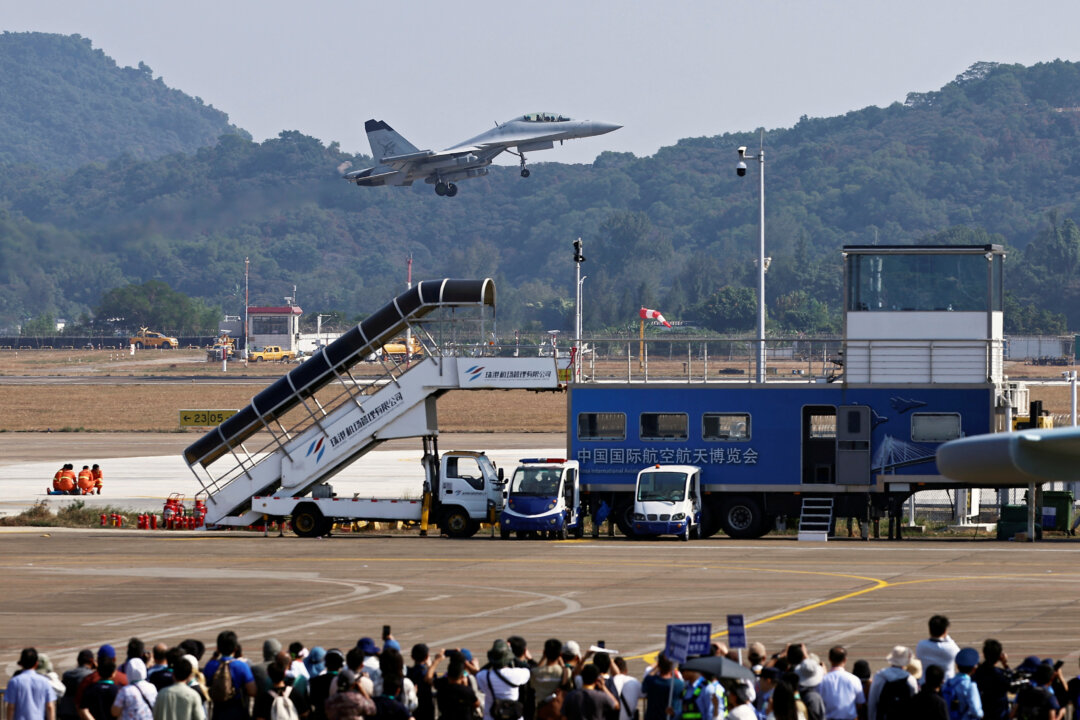Russian Security Council Secretary Sergei Shoigu visited China this week and attended the Zhuhai air show, where the Russian Su-57 stealth jet flew its first foreign demonstration and Russia made its first foreign sale of the fighter jet.
Russian state media reported the sale on Nov. 13 without specifying which country or countries made the purchase.
During a meeting with Chinese Foreign Minister Wang Yi on Nov. 12, Shoigu said the allies’ “most important task” was to counter the United States and its allies’ “dual containment” of Russia and China, according to Russian state media. Wang affirmed the statements, saying the two countries “need to stand firm in solidarity and coordination to safeguard common interests.”
The Zhuhai Air Show is China’s largest, and this year, the focus was on military technology rather than commercial aviation as in previous years. The air show opened on Nov. 12 and runs until Nov. 17.
“Clearly, these developments suggest a continued broad modernization of PLA [People’s Liberation Army] capabilities to defeat U.S. and allied intervention capability as part of a counter-intervention strategy,” said Malcolm Davis, senior analyst at the Australian Strategic Policy Institute.
“They all come together to make Chinese A2AD more lethal and extend its reach.”
A2AD is shorthand for Anti-Access/Area Denial, a military strategy to avoid a head-on fight by making it difficult for the enemy to even enter the battlefield.Among the systems showcased were the latest variant of China’s J-35A stealth fighter, its larger J-20 stealth fighter, a stealthy drone designated the CH-7, the HQ-19 air defense system, a variant of the J-15 naval fighter, and dozens of different munitions.
Chinese media reported that China was demonstrating its ability to protect its interests, while analysts pointed out advancements in military technology.
For instance, the stealth drone’s intelligence, surveillance, and reconnaissance capabilities could be used to direct ballistic missiles, among other things.
“Theoretically, such a platform could undertake maritime surveillance of U.S. Navy activities, including tracking their aircraft carriers and potentially targeting them with indirect fires from IRBMs [intermediate-range ballistic missiles] such as the DF-26,” Davis said.
Shu Hsiao-Huang, a research fellow at the Taiwanese think tank the Institute for National Defense and Security Research, said that because of their small size, these unmanned aircraft could pose a “very big challenge to Taiwan’s air defense surveillance capability.”
The debut of the stealth jet J-35A, which Chinese state-run media described as tasked with “seizing and maintaining air supremacy,” was closely watched, but the press revealed few details about its capabilities.
“Because of the black box typically surrounding PLA miltech developments, we won’t be too certain of the J-35’s performance,” said Collin Koh of the S. Rajaratnam School of International Studies in Singapore.
The J-35 and J-35A are designed and built by the Shenyang Aircraft Corporation, a unit of the state-owned Aviation Industry Corporation of China.
Koh noted that Chinese scientists have made advances in fighter jet technology in recent years. Earlier on, China had relied on Russian technology to advance domestically made fighter jets.
Foreign military attaches and security analysts are closely watching the evolution of J-35 variants, given their importance to Beijing’s aircraft carrier program.
Although China’s three aircraft carriers remain in training and development mode and have yet to stage long-range operations beyond East Asia, a successful J-35 variant is expected to form a key part of the navy’s ability to project power beyond its home waters in coming years.
Reuters contributed to this report.

